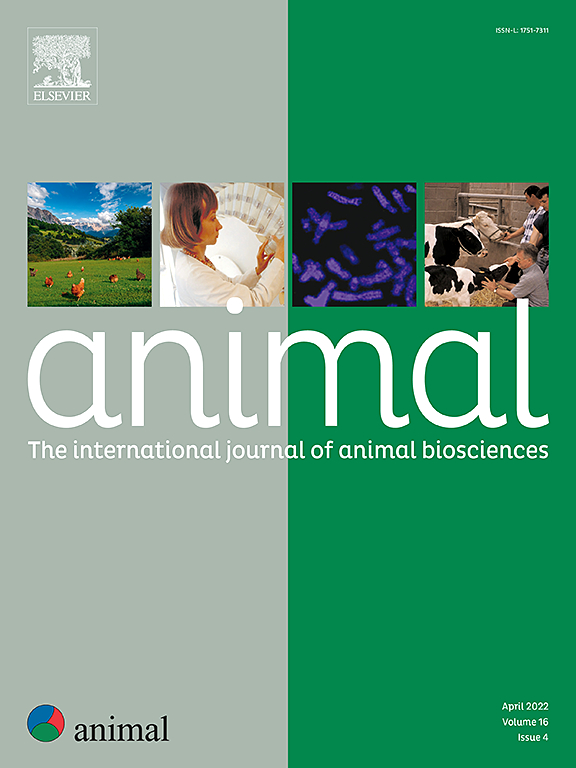综述:建立奶牛行为传感器的精度、偏差和可重复性标准
IF 4.2
2区 农林科学
Q1 AGRICULTURE, DAIRY & ANIMAL SCIENCE
引用次数: 0
摘要
这一范围审查解决了在奶牛行为研究中验证可穿戴传感器的统计方法的差异。本综述的目的是:(1)综合过去11年验证可穿戴传感器观察奶牛行为(活动和喂养行为)的101篇原创研究文章,为研究人员建立参考点;(2)为未来使用可穿戴传感器记录奶牛行为的验证研究提出统计报告(精度、偏差和最低报告标准)建议,重点是计算精度和偏差。(3)评估哪些经过验证的可穿戴设备符合我们的有效性标准;精确度≥85%,报告重复性标准,未观察到偏倚。在PubMed和Web of Science上进行系统搜索得到2955篇文章,删除重复后减少到101篇。使用Power BI进行数据提取,分类准确性、精密度、偏倚、灵敏度、特异性、可重复性、传感器类型、金标准和观察行为。精密度定义为计算出的精密度值,或使用林氏一致性相关系数(CCC)、Pearson相关或线性回归。如果一项研究显示出>; 85%的精度或高相关性/解释变异性(≥CCC或R2 = 0.85),则被认为是精确的。通过Bland-Altman图、均值偏差、最佳拟合线、偏差校正因子或位置尺度移动来确定偏差。再现性要求定义传感器类型、样本量、商业名称和族谱表中的行为。效度标准要求研究必须精确、可重复、无偏倚。研究最多的是活动行为(61/101),其次是进食(59/101)、休息(55/101)和消化行为(49/101)。93%(94/101)的高比例符合重复性标准。然而,只有40%(40/101)计算了精度或使用了代理。在这些报告精度中,90%(36/40)是精确的,95%(38/40)是可重复的,但只有35%(14/40)报告了偏倚。总的来说,只有14%(14/101)的研究符合所有效度标准。经过验证的行为包括活动、进食和消耗。符合有效性标准的传感器有IceCube、Nedap Smart Tag、RumiWatch、Smartbow GmbH、MooMonitor+、Hobo Pendant G和CowManager。未来的验证研究应该优先考虑计算精度、报告样本量和传感器细节,以及统计评估偏差,以确保奶农获得可靠的数据。本文章由计算机程序翻译,如有差异,请以英文原文为准。
Review: Establishing precision, bias, and reproducibility standards for dairy cattle behavior sensors
This scoping review addressed the disparity in statistical approaches for validating wearable sensors in dairy cattle behavior research. The objective of this scoping review was to (1) synthesize 101 original research articles that validated wearable sensors to observe dairy cattle behavior (activity and feeding behavior) from the past 11 years to build a reference point for researchers, (2) make recommendations for statistical reporting (precision, bias, and minimum reporting standards) for future validation research that uses wearable sensors to record dairy cattle behavior, focusing on calculating precision, and bias, and reporting reproducibility criteria, and (3) evaluate which validated wearables met our criteria for validity; ≥ 85% precision, reported repeatability criteria, and no bias was observed. A systematic search across PubMed and Web of Science yielded 2 955 articles, which were reduced to 101 after duplicate removal. Data extraction, performed with Power BI, classified accuracy, precision, bias, sensitivity, specificity, reproducibility, sensor type, gold standard, and observed behaviors. Precision was defined as a calculated precision value or the use of Lin’s Concordance Correlation Coefficient (CCC), Pearson correlations, or linear regressions. A study was considered precise if it demonstrated > 85% precision or high correlations/explained variability (≥ CCC or R2 = 0.85). Bias was identified through Bland-Altman plots, deviations from the mean, best-fit lines, bias correction factors, or location scale shifts. Reproducibility required defining sensor type, sample size, commercial name, and behaviors in an ethogram table. Validity criteria mandated that a study be precise, reproducible, and exhibit no bias.
Activity behavior was the most frequently studied (61/101), followed by consumption (59/101), resting (55/101), and digestive behaviors (49/101). A high proportion, 93% (94/101), met reproducibility criteria. However, only 40% (40/101) calculated precision or used a proxy. Of those reporting precision, 90% (36/40) were precise, and 95% (38/40) were reproducible, but only 35% (14/40) reported bias. Overall, only 14% (14/101) of the reviewed studies met all validity criteria. Validated behaviors included activity, feeding, and consumption. Sensors meeting validity criteria were IceCube, Nedap Smart Tag, RumiWatch, Smartbow GmbH, MooMonitor+, Hobo Pendant G, and CowManager. Future validation studies should prioritize calculating precision, reporting sample size and sensor details, and statistically assessing bias to ensure reliable data for dairy farmers.
求助全文
通过发布文献求助,成功后即可免费获取论文全文。
去求助
来源期刊

Animal
农林科学-奶制品与动物科学
CiteScore
7.50
自引率
2.80%
发文量
246
审稿时长
3 months
期刊介绍:
Editorial board
animal attracts the best research in animal biology and animal systems from across the spectrum of the agricultural, biomedical, and environmental sciences. It is the central element in an exciting collaboration between the British Society of Animal Science (BSAS), Institut National de la Recherche Agronomique (INRA) and the European Federation of Animal Science (EAAP) and represents a merging of three scientific journals: Animal Science; Animal Research; Reproduction, Nutrition, Development. animal publishes original cutting-edge research, ''hot'' topics and horizon-scanning reviews on animal-related aspects of the life sciences at the molecular, cellular, organ, whole animal and production system levels. The main subject areas include: breeding and genetics; nutrition; physiology and functional biology of systems; behaviour, health and welfare; farming systems, environmental impact and climate change; product quality, human health and well-being. Animal models and papers dealing with the integration of research between these topics and their impact on the environment and people are particularly welcome.
 求助内容:
求助内容: 应助结果提醒方式:
应助结果提醒方式:


